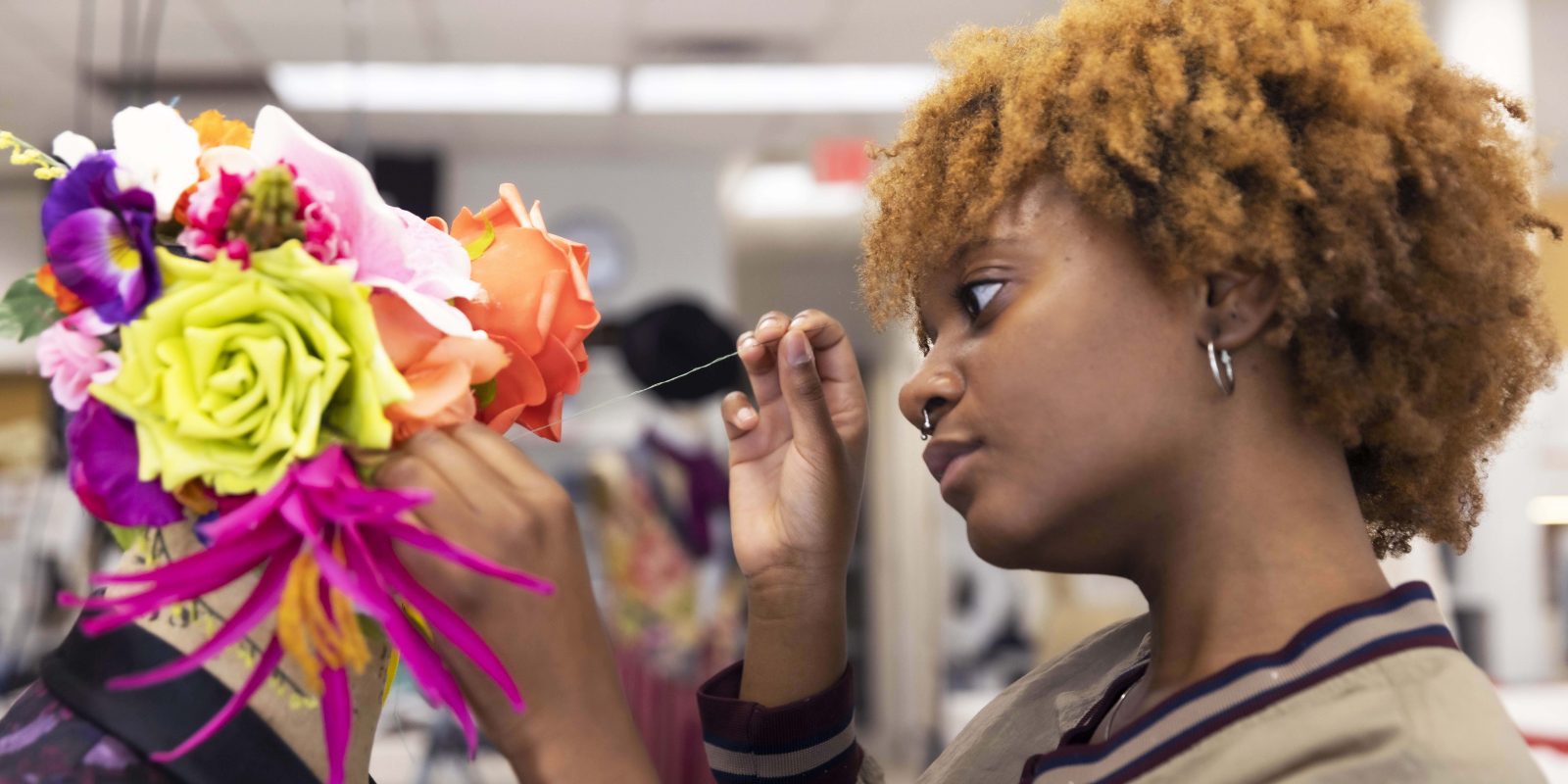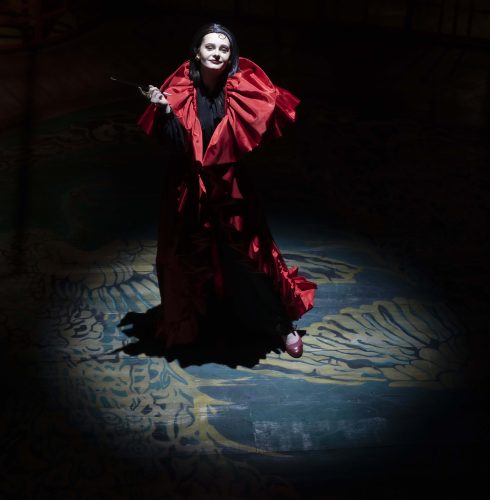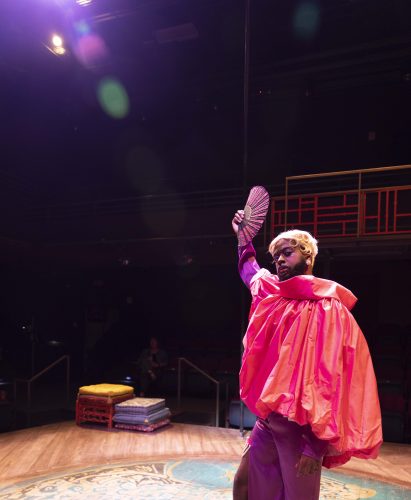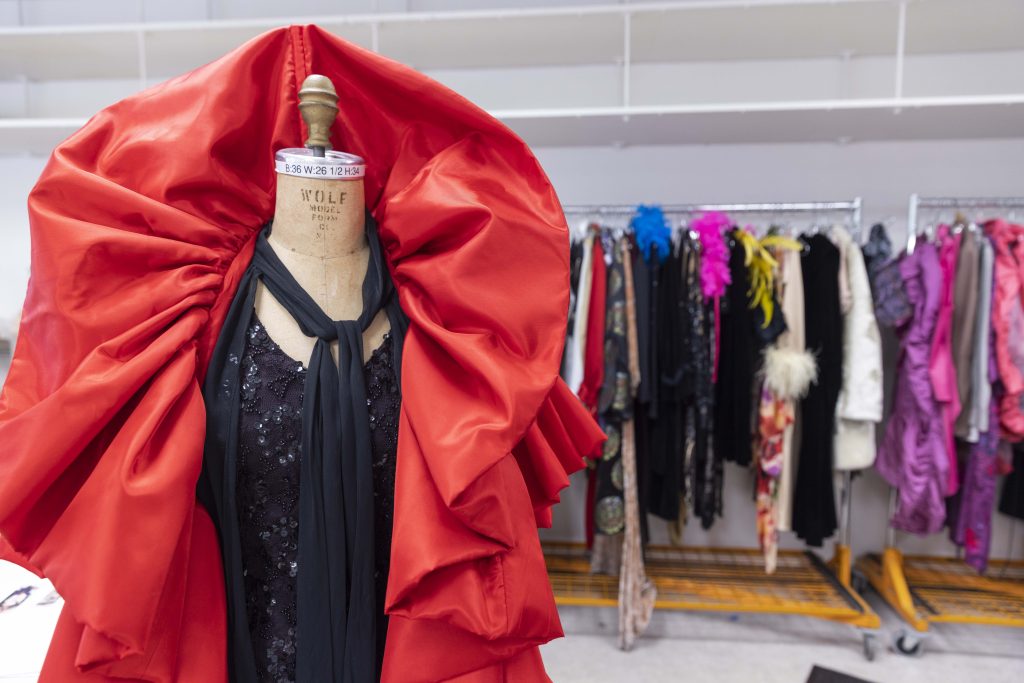
TCU students work with costume studio professionals to design and create stunning outfits for Theatre TCU productions. Photo by Jill Johnson
By Design
In the TCU Costume Studio, professionals and students collaborate and create for the stage.
One spring afternoon in the TCU Costume Studio, first-year musical theatre major Jess Willis was staining leather shoes black. Alex Colig ’22, who earned a BFA in fashion merchandising in May, was shaping and prepping press-on nails at one of the large, muslin-covered worktables. Two other students were labeling undergarments.
Costume Studio manager Michele Alford was overseeing their progress, flitting between her office and the main room.
While the studio is made enchanting by the people fashioning theatrical garments from everyday items — costumes begin to take shape as they’re pinned together on headless dress forms — the space itself is quite ordinary. It used to be a pizza parlor; the plain, windowed storefront in a small strip mall off West Berry Street could be mistaken for it still.
Down Greene Avenue, two old brick houses serve as the studio’s stockrooms, filled with vintage clothes, costumes, hats, wigs, shoes and patterns.
The studio is at a different end of campus than Ed Landreth Hall, which houses theatre classes as well as the performance venues where the completed costumes are needed.
“[We] joked that we need one of those old-fashioned railroad things … with the two people pumping,” said Alford, who had expertise in the fashion industry and as a theatre stitcher and dresser before she took the role with TCU in 2002.
Pinned-up inspiration boards in the back of the studio serve as a guide. In this case, they charted costumes for The Wild Party, a vaudeville musical based on the 1928 poem by Joseph Moncure March. The story follows a passionate couple, Queenie and Burrs, whose relationship falls apart. They decide to host a party with a cast of over-the-top characters; the evening descends into debauchery.

Hannah Le Beau takes the stage as Madelaine True in Theatre TCU’s production of “The Wild Party,” wearing a design created by the TCU Costume Studio for the spring 2022 show. Photo by Jill Johnson
Traditionally, characters in the musical have been dressed in elegant 1920s attire reminiscent of The Great Gatsby, but the TCU team reimagined the costumes.
“They’re vaudeville performers on Broadway in New York. They probably live in a big warehouse or apartment somewhere off Midtown,” said Murell Horton, associate professor of theatre. “And so, we’re just sort of like, ‘Shouldn’t they be clowns and acrobats and magicians?’ ”
Horton is the costume designer and mentor to student designers in the department. “I’m a storyteller first,” said Horton, an award-winning costume designer who worked for more than 25 years in New York.
Costume design begins with historical research, sketches and inspiration pieces pulled from stock or from stores. The next stage is fittings.
In the costume fitting for Queenie, portrayed by Annie Cahill ’22, Horton and Cahill, who earned a BFA in musical theatre in May, considered a corset top paired with a metallic gold fringe skirt sourced from the Anthropologie clearance rack.
“Now I didn’t want to give Queenie jewelry because of all the violence and stuff. … I didn’t want any of it to get tugged off,” Horton said, noting that the character is in an abusive relationship. The purpose of fittings is to study the actor’s movement in the clothing, Horton said. The designer and performer also assess which pieces need to be rigged for easier changing.
Collaboration
Students make up a large part of the studio’s rotating cast. “A lot of my friends work here. We talk drama, we talk shop, we talk about life,” said Willis, now a sophomore. Most of the students who work in the studio are involved in theatre in some other capacity as well, whether in the classroom, on stage or backstage on the tech crew.
Alford said that she often asks the students how they feel about goings-on in the theatre department, such as how a post-mortem — an evaluation of the show’s run — went. It’s very democratic. “I’ve worked in some very toxic environments, especially in fashion. I’m in charge of the tone of the space,” Alford said. “And I’m not going to let it be a toxic work environment.”

D’Mariel Jones was a lead designer for “The Wild Party.” He also played one of the D’Armano brothers in the show. Photo by Jill Johnson
D’Mariel Jones ’22, who earned a BFA in musical theatre, was one of the lead designers for The Wild Party. He also played one of the D’Armano brothers in the show; the siblings are composers and entertainers. Though Jones intends to pursue performance and directing, his interest in fashion drove him to the studio.
The costumes for the six characters he oversaw included vibrant colors, feminized suits and just “the craziest things imaginable.” For his character, Jones designed a pair of purple trousers and a matching purple jacket worn over a corset with a peplum; he completed the ensemble with heeled white boots and a ruffled pink cape.
“The fun thing about this show is that everything kind of goes,” Jones said.
Mission of Reuse
The studio has made reducing waste part of its mission. In 2018, the EPA estimated that the textile industry produced 17 million tons of materials, with only 2.5 million tons being recycled. The studio’s efforts include shopping at estate sales and making use of items already on hand.
A bolt of bright red fabric received as a donation during the pandemic was pulled to create a dramatic cloak with voluptuous ruffles for The Wild Party. Designed by Jones and put together by Ryenne Bishop ’22, who earned a BFA in theatre studies, the cloak was just the latest example of how the studio uses secondhand materials to outfit actors in style.

Designers at the TCU Costume Studio find materials from places including thrift shops and estate sales. Photo by Jill Johnson
Floor-length silk curtains with slight water damage were among recent donations. Student workers ripped the curtains at the seams to store the salvageable material and lining on fabric bolts until they are needed in a show.
Damask tablecloths found at an estate sale were turned into men’s shirts for Tartuffe, and tea towels became folk aprons for Fiddler on the Roof. Estate sales are also good for sourcing props and accessories; recent finds included a brown derby hat and a lint brush for wool coats.
Keeping with its mission, when the studio can’t find a use for materials, it donates goods to the Welman Project, which serves local teachers, or Berry Good Buys, a thrift store benefiting SafeHaven of Tarrant County.
From Studio to Stage
On the night of the dress rehearsal, the studio’s work was put to the test. Roy Turpin, the staff costume technician who creates the patterns, said seeing the costumes in context is a different experience. Inhabited by actors under the lights on the Hays Theatre stage, made to resemble a New York City loft, the costumes came alive.
The ruffled trim of the bright red cloak framed the face and form of Madelaine True, played by senior musical theatre major Hannah Le Beau. As she made her entrance, head held high, the floor-length cloak billowed behind her.
Cahill, sporting a Marilyn Monroe-style blond wig and red lipstick, revealed Queenie’s gold corset and skirt by dropping her long, black faux fur coat to the floor. The glittering fringed skirt accented her movements on stage.
Jones’ white boots shone as he stalked onto the stage as Oscar D’Armano. One leg, accented by a pearl garter, showed through a long slit as he snapped open a fan.
After the run of the show, the team piled costumes into a van and transported them back to the studio for laundering. Then they hung the costumes up in the stock houses, ready to be re-imagined.
Alford said important life skills are learned in the costume studio beyond sewing and ironing.
“Anybody would be better off in their life having worked here. You learn how to communicate and collaborate and lead teams,” she said. “We just make you hop in.”

A bright bolt of red fabric, donated during the pandemic, turned into Madelaine True’s cape for the 2022 production of “the Wild Party.” Photo by Jill Johnson

Your comments are welcome
Comments
Related reading:
Alumni, Features
John Devereaux Shines in Hamilton Spotlight
The performer landed the opportunity of a lifetime after years of auditioning.
Research + Discovery
Theatre Students Adjust and A.D.A.P.T. in Pandemic
A free-form digital project combines creativity with technology.